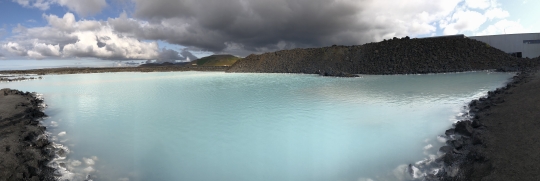Reykjavik is an old haunt of mine, a favorite place to which I have not returned in all too long. I was delighted, then, to hear from Angelle Tanner, who in August attended the Extreme Solar Systems IV conference there. I had the pleasure of getting to know Dr. Tanner in Knoxville when we both spoke at a biosignatures session at the 2017 symposium of the Tennessee Valley Interstellar Workshop. Dr. Tanner received her PhD at UCLA, did postdoc work at both Caltech and Georgia State, and is now an associate professor at Mississippi State University. Her work specializes in exoplanet detection and programs devoted to understanding the properties of stars that host planets, as well as the architecture of the systems that evolve around them. It’s a pleasure to turn today’s essay over to Dr. Tanner for a look at exoplanetary events in Iceland’s capital.
by Angelle Tanner

Mid-August marked the fourth meeting of the Extreme Solar Systems conference — this one in Reykjavik, Iceland – touted as one of the biggest exoplanet-themed astronomy conferences of the year. Meetings I-III were hosted in Santorini, Greece; Jackson Hole, Wyoming and The Big Island of Hawaii – all parts of the world with extreme geology. Reykjavik was no exception, with glaciers, volcanoes and geysers within driving distance of the conference venue at the Harpa Concert Hall and Conference Center. It is a beautiful building right on the water with sharp cliffs and fishing and excursion boats in plain view.
To keep with the conference theme, I’ll cover some of the science highlights by investigating the extreme properties of exoplanets, their host stars and our own Solar System. Some of these results may sound familiar as they were announced globally via press releases that were embargoed until their presentation at the meeting.

Image: Harpa Concert Hall and Conference Center in Reykjavik. Credit: Angelle Tanner.
Common vs. Rare
As expected, planets around M-dwarfs were in full force at this meeting as we heard about exciting new discoveries on the first day. David Charbonneau (Harvard), speaking for his postdoc Jennifer Winters, told us about the complex triple M-dwarf system LTT 1445. It has a TESS-discovered transiting planet orbiting the A stellar component of the system. While the mass of the planet around LTT 1445 A still needs to be determined, the fact that it transits its M-dwarf host star makes it a good target for JWST.
We will be able to determine the composition of the atmosphere of the planet from transit spectroscopy not currently possible with ground or space-based telescopes as we can’t quite reach the necessary signal-to-noise yet. M-dwarfs constitute the majority of stars in our galaxy and have become high priority targets for planet search programs. This system will join the Trappist-1, GJ 1214 and GJ 518 M-dwarf planetary systems, to name a few which are getting plenty of attention, as we characterize each planet and further investigate these types of systems. They are not only the most common in our galaxy but may be our best chance to look for life outside of our Solar System.
At the other population extreme are those rare planets in orbits with very high eccentricities. Shasha Hinkley (University of Exeter) spoke about what could eventually be the first directly imaged hot Jupiter planet. How? Well, turns out the planet orbiting HD 20782 has an orbital eccentricity of 0.97! With an orbital period of ~600 days, the planet gets as close as 0.04 AU and as far as 2.7 AU (0.072″) from its host G1.5V star (data from exoplanet.eu).
With its widest separation of 0.07″ at apastron, this planet is tantalizing close to the limit on the inner working angle of many coronagraphic systems available today like SPHERE on the VLT or GPI on Gemini. Hinkley’s team was not able to image the planet due to a little too much stellar saturation in their non-coronagraphic images, but I’m sure they will try again. They were able to determine that there are not any 20-60 MJ objects further out from the star, which makes us wonder why this planet still retains such a high orbital eccentricity.
Young vs Old
Discoveries of new planets around young stars were some of the highlights of the meeting. Young stars are problematic for planet search programs, as their tendency to be photometrically active hinders planet discovery via radial velocities, and the large distances to young stellar clusters (50 – 100 pc) requires sophisticated coronagraphic direct imaging instruments and analysis tools.
Marie LaGrange (INST) announced the detection of an additional planet around Beta Pictoris. This young star has been in the news for decades, as its edge-on debris disk was first observed with the IRAS telescope in 1983 and the planet beta Pic b, which is in an edge-on orbit but does not quite transit, was first confirmed in 2018. This time the existence of the second planet, beta Pic c, is inferred from radial velocity measurements. Getting a thorough census of the planets in this system is important to help understand planet formation and evolution and also how the planets influence the structure of the disk, which has moving clumps and is warped.
There was another announcement of the discovery of a planet (or two) around a well-known young star with an edge-on disk. Peter Plavchan (George Mason University) announced the discovery of the planets via both TESS transit photometry, and follow-up radial velocity measurements with the new iSHELL infrared echelle spectrometer on the NASA IRTF telescope. Due to the fact that the paper is still under review by Nature (I’m a co-author), the name of the host star is still hush, hush. Stay tuned!
At the other age extreme, we have the remains of dead planets being detected in the atmospheres of white dwarfs. White dwarfs have very simple spectra, with mostly just absorption lines from H and He. Over the past few years, astronomers have detected multiple heavy elements including Fe, Mg, Ca and Si. This meeting hosted a few different speakers including Christopher Manser (University of Warwick) who announced the first detection of a planetesimal orbiting a white dwarf. His team tracked changes in the shape of the Ca II line and noticed variations over a timeframe of just 2 hours. They then determined that the material causing the variations is a solid object and, therefore, is a chunk of material still in orbit around the white dwarf [see White Dwarf Debris Suggests a Common Destiny]. This is a young and super exciting sub-field of exoplanet research which allows us to study the composition of the insides of rocky planets while we are still developing new methods to study their atmospheres.

Image: Iceland’s Blue Lagoon, a popular geothermal spa. There is a volcano caldera in the background. Credit: Angelle Tanner.
Hot vs Cold
One of the hottest extrasolar planets both literally and figuratively at this meeting was Kelt 9b. At an orbital distance of 0.034 AU around an A-class star, this planet has an average surface temperature of 4050 K. The intense heat this planet is receiving from its star results in a unique set of elements detectable in its atmosphere. Enric Palle (Gran Telescopio Canarias) updated us on the Carmenes planet atmosphere survey of 25 known transiting planets. Kelt 9b is on their target list and they have detected ionized iron and titanium in the atmosphere of this super-heated planet. This survey has also detected He in the atmospheres of three different planets, which is good to know as we make plans to travel across the galaxy.
From the extremely hot to the extremely cold (kinda), Sarah Blunt discussed the detection of a planet around the G0V star HR 5183 using radial velocity measurements. Proto-doctor Blunt made some audience members groan as she mentioned that the first RV measurement in her data set was collected before she was born (1997); however, our persistence as observers has paid off as the RV signal shot up over the past few years, revealing the presence of an extremely eccentric planet at a current distance of 18 AU from the host star. It will reach a distance of 30 AU over the course of its ~74 year orbit. We again are left to ask why this planet has such a high eccentricity with no known other planets in the system and no stellar companion close enough to cause its current configuration. Additional direct imaging and Gaia astrometric measurements will give us more information about this puzzling system [see HR 5183 b: Pushing Radial Velocity Techniques Deeper into a Stellar System].

Image: An iceberg from Iceland’s Jökulsárlón, or ‘Glacier’s-River-Lagoon’. Credit: Angelle Tanner.
Bright vs. Dark
Our final set of extremes comes from pitting the bright against the dark. We start with thinking about objects which are so bright we can see them with binoculars – the Galilean moons! Laura Mayorga opened the Thursday session reminding us that there are objects in our own Solar System that we can study to help us better understand exoplanets. She looked at the phase curve of the reflected light from Io and concluded that we need to stop using Lambertian curves (consider a cueball) to model reflected light curves. She also determined that an Earth-sized planet with a surface similar to Io would have a reflected light contrast of 10-9 to 10-10. This is indeed the contrast ratio being targeted by upcoming space missions such at LUVOIR and the Origins telescope, intent on direct imaging of Earth-like worlds. While we’ve known these contrast values are necessary for future direct imaging missions it is still useful to have observational confirmation and new phase curves for direct comparisons to future data sets.
We finish with one of the biggest announcements of the meeting, as Laura Kreidberg gave an exciting talk about measuring the first thermal phase curve of a terrestrial planet. Her team observed the transiting planet, LHS 3844 b with the Spitzer Space Telescope. Over the course of the planet’s very close 0.006 AU orbit around the M-dwarf host, Spitzer can detect changes in the amount of infrared light from the planet as seen here in our Solar System similar to the change in the phase of Venus we see on Earth as we both orbit the Sun [see LHS 3844b: Rocky World’s Atmosphere Probed].
From the significant amplitude of the change in thermal emission over the planet’s orbit, we can infer that this planet not only lacks any appreciable atmosphere but is most likely composed of a dark, basaltic rock like the moon and Mercury. In this golden age of exoplanet science, we are not only detecting and characterizing the atmospheres of extrasolar planets now but are now making informed assertions on the composition of the surface materials!
There were two other results that caught my attention but could not be cleverly placed in the context of extremes. Eric Nielsen (Stanford) and a few other folks reported on the statistical results of direct imaging programs like GPI and SHINE. There appears to be a difference in the types of stars that have planetary companions on wide orbits versus those with brown dwarfs.
Stars with masses > 1.5 Msun are more likely to host planetary mass companions, which suggests these objects were formed via the core accretion mode of planet formation. Brown dwarfs, on the other hand, seem to form more around stars < 1.5 Msun, favoring the gravitational instability planet formation model. These trends are observed from their 300-star GPI direct imaging survey.
Finally, Lisa Kaltenegger (Cornell University) stayed true to her appointment at the Carl Sagan Institute and went way out there with a trip into alien oceans. She talked about the different depths to which light would penetrate the oceans on a habitable planet around early vs late-type stars. The light from an M-dwarf star, mostly in the infrared, would penetrate only the top few meters of an alien ocean, while light from an F-type star would make it into deeper depths.
Most intriguing was her suggestion that life in some of these M-dwarf worlds would need to somehow break down the UV light expected from the flares that are common for these types of stars. Recall that the habitable zone for M-dwarfs can be a fraction of an AU and well within the reach of life-damaging flares. She then showed a cool animation of the surface of an alien world fluorescing in reaction to a UV flare, which made us all wonder if this could one day be detectable from own humble world [see Looking for Life Under Flaring Skies].
This was a small sample of the menagerie of juicy exoplanet news covered during a subset of the talks presented at this meeting. There were also a few hundred posters covering anything from new planets to new instruments to upcoming NASA exoplanet missions. The best is yet to come! There has been no news yet about the location of Extreme Solar Systems V… I’m rooting for New Zealand!



The lack of more energetic radiation from M-dwarfs and the low penetration depth of the light would imply a very shallow photic zone. While Kaltenegger is hoping to detect fluorescent organisms, I wonder if life will be largely restricted to the oceans, and that photosynthesis (terrestrial type) will be activated during stellar flares. Photosynthesis would occur at safe depths where the radiation was moderated to optimize between energy capture and use for cellular repair. Photosynthesizers would therefore not be ruled by day-night cycles, but tidally locked planets in the HZ would receive the necessary light during flare activity. This would drive growth cycles for autotrophs. The heterotrophs feeding on them would then create rather deep population cycles as they continued feeding during periods when the autotrophs were dormant. Behavioral solutions to flares using the ocean as the needed shield seems to me a more likely solution than trying to evolve fluorescence as a shield to survive exposed on dry land where the flare intensity may not be reliable. Earth organisms have evolved behavioral solutions and are therefore an existence proof that M-dwarf planet organisms may evolve similar solutions. Alternatively, life may be restricted to anaerobic metabolism as photosynthesis may prove too difficult to evolve under such conditions. Such organisms may remain in the ocean depths and floors, safe from any flare activity impacting the surface.
Someday there may be conferences on life in extreme solar systems.
Would life be possible in deep canyons on planets in the potential habitable zone around M-dwarfs? I’m wondering if shaded areas such as deep canyons would provide protection from UV flares. Something like the idea of craters on the moon with ice water remaining because sunlight cannot reach it. Thank you for the wonderful summary by the way Dr. Tanner. I remain convinced life will find a way to survive in the most unlikely seeming places.
Just the “right” amount of water would be needed to have both oceans and land. Exiting the ocean onto land would be needed to develop tho ability to control fire and electricity. Tidal locking would of course substantially complicate the situation, as would great variations in the intensity of radiation. And while little, sheltered bodies of water may host abiogenesis, a less constrained milieu may offer a better chance, both for the initiation of life and its progression towards intelligence.
You reminded me that we just had a post that indicated that a planet needs to rotate to ensure ocean currents and nutrient mixing. A tidally locked planet may result in ocean stagnation, with only surface winds able to mix water to a shallow depth. That would certainly be a problem for autotrophs generally, especially those in the ocean that need to trap solar energy nearer the surface.
Whether tides also are necessary for emergence onto land or not maybe another question that we have no data on.
Life may “always find a way” (- Ian Malcolm) but it may be hard to evolve the needed energy metabolism to support photosynthesis and aerobic metazoa.
Thanks for this report, there were definitely a lot of interesting topics going on judging by the abstracts list on the website! I reckon I have a fairly good guess as to the Plavchan et al. mystery system, if so it’s been mentioned a couple of times in various other (publically-available) slides and arXiv preprints…
There was also an interesting abstract from Cecilia Lazzoni about potential giant (Jupiter-mass) satellites of brown dwarfs, there’s a bit more information in this Sky & Telescope article. Would be interesting to see if these hold up to further observations, perhaps the Kepler-1625 exomoon candidate isn’t particularly extreme as these things go.
He actually slipped and said the name of the system and then let out a nice expletive. I am not going to let him forget that for a couple years at least. The whole embargo idea for Nature/Science is just getting silly in the era of instant news/social media.
Some of us were a little weary of the exomoon discovery. We are worried that they are located within the Airy ring of the images which, I can attest to personally, vary in structure quite a bit with seeing conditions.
I fully agree with this. I’m not sure they do much to help the accuracy of reporting science results to the public, either.
Thanks for the info. That would be unfortunate, but I’m still impressed that detecting exomoons is looking more and more like becoming a viable prospect – I remember when the exoplanet count was down at “maybe some weird objects orbiting a pulsar”…
If a tidally locked planet has a stagnant ocean, could earthquakes provide adequate mixing?
I read about an exoplanet system with planets approaching very closely. Could they provide enough tidal force for ocean mixing?
Have you totally ruled out tidally locked planets having moons? We’ve seen other surprising things, maybe a tiny moon, or a temporary one…